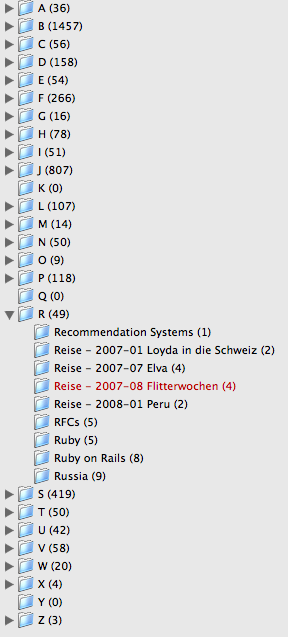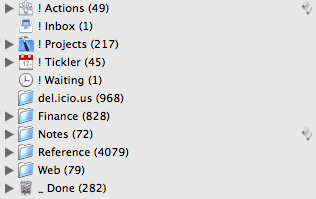In a previous article I gave an introduction to GTD. In this post I’ll describe how I actually implemented that system using the fabulous DEVONthink.
DEVONthink Pro
First a word of introduction. If you don’t use DEVONthink yet, I recommend you to try out specific tools like iGTD or kgtd first. They may be better suited to implementing a basic GTD system. I went with DEVONthink because all my reference material is already in there and so putting in my actions and projects into the same system makes sense. Additionally I don’t mind some custom hacking and customization which definitely is necessary with DEVONthink.
I believe with DEVONthink Personal you won’t be able to do some things I describe - for example script support is missing. I personally use DEVONthink Pro Office but DEVONthink Pro will suffice for what I describe here.
To give you an idea how addicted I am to that tool, here is what I store in by DEVONthink database:
- Almost all documents I get via snail mail - scanned with OCR so they are full-text searchable.
- Important documents I get via e-mail.
- Snippets of online news articles. I use the command “Take Rich Note” in the service menu so I can do that from Safari and other applications.
- All my del.icio.us bookmarks.
- Notes I wrote about usage of a specific technology, software, etc.
- Electronic books of different programming languages and technologies. For example some PDF books from the Pragmatic Programmers.
- Book keeping. I use the Sheet/Record functionality of DEVONthink with the addition of an AppleScript to do a basic income/expense analysis by month.
So you can clearly see, that I am addicted to that program and have basically stored my recent life in there. And I take a lot of care about backing up that database regularly. Because of that for me it makes a lot of sense to add my GTD setup in the same database.
Reference
Based on a comment in the book, one of the first things I tried out is to store all my reference material alphabetically. Before I had complicated hierarchic structures which made filing and also navigating increasingly harder. Now I have the Reference folder containing just the alphabet. And below that the folders are filed with almost no hierarchy.
See the example in the screenshot:

Folder Structure
Next I created a GTD folder structure. I have these root folders now:

- Actions: Next Actions
- Inbox: Where I put stuff. I configured that as the destination of new notes in the setting (Preferences → Import → New notes)
- Projects: One subfolder for each active project plus a list of “Future projects”
- Tickler: The tickler / 43 folders structure from the book. I am still experimenting with it and am not yet really convinced that I like it.
- Waiting: Actions that are pending because I’m waiting for input by some other person.
- del.icio.us: All my bookmarks from del.icio.us. Automatically imported about once a day.
- Finance: Balance sheets and all my scanned documents. As the offline documents I get are 95% finance related, the group name is appropriate for me.
- Notes: Short notes about stuff I do, etc. that I can’t file in a specific reference place. Usually it’s phone conversations or short quotes I read somewhere.
- Reference: My reference folder, see above.
- Web: Links to web sites that I often read inside DEVONthink and feeds.
- Done: Actions that have been completed. One subfolder per month. I like keeping archives, storage is cheap nowadays.
Contexts
The contexts are handled as subfolders of Actions. errands, home, etc.
Projects
The project folder contains one subfolder for each project where I store documents. Additionally for projects that require files on the file system - code for example - I create a folder with the same name in a file system project folder.
Scripts
With the help of AppleScripts I make two aspects of the handling easier: creating of actions and archiving them.
Both of these scripts I have from John Wiegley. downloaded from the DEVONacademy scripts site.
DEVONthink Jot Task
I use the Jot script to quickly create new actions. It prompts for a title and creates a new task in the Inbox with that name. From there I manually move it into a project folder or into a context.
on handle_string(s)
tell application "DEVONthink Pro"
set theInbox to create location "/! Inbox"
set theRecord to create record with {name:s, type:txt} in theInbox
set state visibility of theRecord to true
end tell
end handle_string
on run
tell application "DEVONthink Pro"
activate
display dialog "Create a quick task: " default answer ""
my handle_string(text returned of the result)
end tell
end run
This script I made accessible using the F6 key through Quicksilver. To set up that, go to the Quicksilver settings, Triggers, Custom Triggers. There create a new HotKey, select the AppleScript you saved somewhere on your disk and assign it the trigger you want.
Move Contents to Done
The collection also includes a script called “Move Contents to Done” to archive completed actions.
on moveCompleted(theRecord)
tell application "DEVONthink Pro"
set theChildren to children of theRecord
repeat with theChild in theChildren
if state of theChild is true and state visibility of theChild is true then
set theGroup to create location "/_ Done"
move record theChild to theGroup
else
my moveCompleted(theChild)
end if
end repeat
end tell
end moveCompleted
on triggered(theRecord)
try
my moveCompleted(theRecord)
on error error_message number error_number
if the error_number is not -128 then
try
display alert "DEVONthink Pro" message error_message
on error number error_number
if error_number is -1708 then display dialog error_message buttons {"OK"} default button 1
end try
end if
end try
end triggered
Save that script somewhere on your disk, open the Info panel of the Actions folder (menu Tools, Show Info) and assign the script.
Icons
I took some time to find nice icons for the folders. It makes looking at this tool a lot nicer. The icons are extracted from several Mac OS X tools (iCal, XCode, Mail.app). Right-click any application on your disk and select “Show Package Contents” in the menu. Then in the folder “Contents”, “Resources” you find the icons of the application.
Conclusion
I have used that system in DEVONthink for about three months now. I even used it for the biggest project in my life so far: the wedding.
Being able to easily link to reference material and scanned documents from actions has been a killer feature for me.